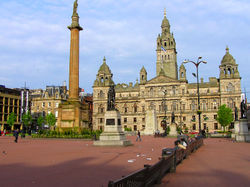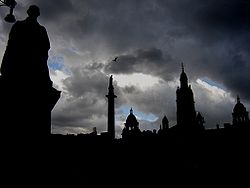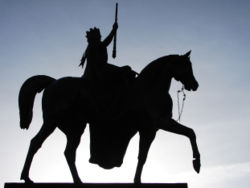
George Square
Encyclopedia



Town square
A town square is an open public space commonly found in the heart of a traditional town used for community gatherings. Other names for town square are civic center, city square, urban square, market square, public square, and town green.Most town squares are hardscapes suitable for open markets,...
in the city of Glasgow
Glasgow
Glasgow is the largest city in Scotland and third most populous in the United Kingdom. The city is situated on the River Clyde in the country's west central lowlands...
, Scotland
Scotland
Scotland is a country that is part of the United Kingdom. Occupying the northern third of the island of Great Britain, it shares a border with England to the south and is bounded by the North Sea to the east, the Atlantic Ocean to the north and west, and the North Channel and Irish Sea to the...
. It is named after King George III.
Historical development
George Square was laid out in 1781, part of the innovative Georgian central grid planGrid plan
The grid plan, grid street plan or gridiron plan is a type of city plan in which streets run at right angles to each other, forming a grid...
that initially spanned from Stockwell Street east to Buchanan Street
Buchanan Street
Buchanan Street is one of the main shopping thoroughfares in Glasgow, the largest city in Scotland. It forms the central stretch of Glasgow's famous shopping district with a generally more upmarket range of shops than the neighbouring streets: Argyle Street, and Sauchiehall Street.-History:...
—which reflected the growing rational influence of the Scottish Enlightenment
Scottish Enlightenment
The Scottish Enlightenment was the period in 18th century Scotland characterised by an outpouring of intellectual and scientific accomplishments. By 1750, Scots were among the most literate citizens of Europe, with an estimated 75% level of literacy...
, along with the similar development of Edinburgh
Edinburgh
Edinburgh is the capital city of Scotland, the second largest city in Scotland, and the eighth most populous in the United Kingdom. The City of Edinburgh Council governs one of Scotland's 32 local government council areas. The council area includes urban Edinburgh and a rural area...
's New Town
New Town, Edinburgh
The New Town is a central area of Edinburgh, the capital of Scotland. It is often considered to be a masterpiece of city planning, and is a UNESCO World Heritage Site...
. This grid iron masterplan across the lands of Meadowflats and eventually as far west as Blythswood Hill
Blythswood Hill
Blythswood Hill is an area of Glasgow, Scotland.It lies to the immediate west of the city centre and as the name suggests rises to a plateau before dipping again towards the west end area of Woodlands....
, was largely the work of the notable contemporary architects James Barry, James Craig
James Craig (architect)
James Craig was a Scottish architect. His brief career was concentrated almost entirely in Edinburgh, and he is remembered primarily for his layout of the first Edinburgh New Town.-Date of birth:...
and James Gillespie Graham
James Gillespie Graham
James Gillespie Graham was a Scottish architect, born in Dunblane. He is most notable for his work in the Scottish baronial style, as at Ayton Castle, and he worked in the Gothic Revival style, in which he was heavily influenced by the work of Augustus Pugin...
.
For the first few years however it was little more than a muddy hollow, filled with dirty water and used for slaughtering horses. Between 1787 and the 1820s, the square was eventually opened up and lined with Georgian
Georgian architecture
Georgian architecture is the name given in most English-speaking countries to the set of architectural styles current between 1720 and 1840. It is eponymous for the first four British monarchs of the House of Hanover—George I of Great Britain, George II of Great Britain, George III of the United...
townhouses at its east and west ends, as well as hotels. 1842 saw the opening of Queen Street Station
Glasgow Queen Street railway station
Glasgow Queen Street is a railway station in Glasgow, Scotland, the smaller of the city's two main line railway termini and the third-busiest station in Scotland. It is between George Street to the south and Cathedral Street Bridge to the north, at the northern end of Queen Street adjacent to...
as the Glasgow terminus of the Edinburgh and Glasgow Railway
Edinburgh and Glasgow Railway
The Edinburgh and Glasgow Railway was a railway built to link Glasgow and Edinburgh. The Act of Parliament for building the railway received its Royal Assent in 1838 which was open on 28 July 1863. Services started between Glasgow Queen Street and Haymarket on 21 February 1842. The line was...
. By 1850 the surrounding area had become a centre for mercantile activity, with the Merchants House moving to the square in 1877, and the square itself, which had been developed into a private garden for the surrounding townhouses, became an established public space, after frequent disturbances and pulling down of railings by a disgruntled mob.
The square was named after George III, a statue of whom was originally intended to occupy the centre of the square, but the turmoil and anxiety caused to the city's Tobacco Lords
Tobacco Lords
The Tobacco Lords were Glasgow merchants who, in the 18th Century made enormous fortunes by trading in tobacco from Great Britain's American Colonies....
by the War of American Independence in 1775 and eventual British defeat in 1783, coupled with his ever more frequent bouts of madness had created mixed feelings toward the Hanoverian and so it was decided instead to commemorate Sir Walter Scott, which, incidentally, was the first ever memorial dedicated to him.
Prominent buildings
Today the east side of the square is dominated by the ornate Glasgow City ChambersGlasgow City Chambers
The City Chambers in Glasgow, Scotland has functioned as the headquarters of Glasgow City Council since 1996, and of preceding forms of civic government in the city since 1889, located on the eastern side of the city's George Square...
, headquarters of Glasgow City Council, which opened in 1888. On the South side are a number of buildings, including the former General Post Office, built in 1878 and redeveloped into offices in 2007, a Chicago-style
Chicago school (architecture)
Chicago's architecture is famous throughout the world and one style is referred to as the Chicago School. The style is also known as Commercial style. In the history of architecture, the Chicago School was a school of architects active in Chicago at the turn of the 20th century...
office building, dating from 1924 and there is also the city's main Tourist Information Centre.
The North side consists of Queen Street Station
Glasgow Queen Street railway station
Glasgow Queen Street is a railway station in Glasgow, Scotland, the smaller of the city's two main line railway termini and the third-busiest station in Scotland. It is between George Street to the south and Cathedral Street Bridge to the north, at the northern end of Queen Street adjacent to...
, the North British Railway
North British Railway
The North British Railway was a Scottish railway company that was absorbed into the London and North Eastern Railway at the Grouping in 1923.-History:...
Hotel (now the Millennium Hotel), which date from the 1840s, and George House, which replaced an older Georgian building, built in 1979 to provide extra office space for Glasgow City Council, and now the offices of Ernst & Young
Ernst & Young
Ernst & Young is one of the largest professional services networks in the world and one of the "Big Four" accountancy firms, along with Deloitte, KPMG and PricewaterhouseCoopers ....
.
Queen Street, running parallel to the square's West side, features the city's Chambers of Commerce
Chamber of commerce
A chamber of commerce is a form of business network, e.g., a local organization of businesses whose goal is to further the interests of businesses. Business owners in towns and cities form these local societies to advocate on behalf of the business community...
building, which was designed by John Burnet
John Burnet (architect)
John Burnet was a Scottish architect who lived and practised in Glasgow. He was born the son of soldier and trained initially as a carpenter, before becoming a Clerk of Works...
and opened in 1874, two storeys were added by JJ Burnet
John James Burnet
Sir John James Burnet was a Scottish Edwardian architect who was noted for a number of prominent buildings in Glasgow, Scotland and London, England...
in 1907 and are topped by a domed tower on which is perched a ship on a globe, a reminder of the importance of sea trade to Glasgow's prosperity. The western side is also the location of the former Bank of Scotland
Bank of Scotland
The Bank of Scotland plc is a commercial and clearing bank based in Edinburgh, Scotland. With a history dating to the 17th century, it is the second oldest surviving bank in what is now the United Kingdom, and is the only commercial institution created by the Parliament of Scotland to...
building, which is now offices and a Wetherspoons
Wetherspoons
J D Wetherspoon plc is a British pub chain based in Watford. Founded as a single pub in 1979 by Tim Martin, the company now owns 815 outlets. The chain champions cask ale, low prices, long opening hours, and no music. The company also operates the Lloyds No...
restaurant and bar.
The eastern side of the square itself is flankd by two lawn
Lawn
A lawn is an area of aesthetic and recreational land planted with grasses or other durable plants, which usually are maintained at a low and consistent height. Low ornamental meadows in natural landscaping styles are a contemporary option of a lawn...
s and is also the site of the city's Cenotaph
Cenotaph
A cenotaph is an "empty tomb" or a monument erected in honour of a person or group of people whose remains are elsewhere. It can also be the initial tomb for a person who has since been interred elsewhere. The word derives from the Greek κενοτάφιον = kenotaphion...
, which was designed by JJ Burnet and originally built to commemorate Glaswegians killed in the First World War
World War I
World War I , which was predominantly called the World War or the Great War from its occurrence until 1939, and the First World War or World War I thereafter, was a major war centred in Europe that began on 28 July 1914 and lasted until 11 November 1918...
when it was erected in 1922 by the Earl Haig Fund. An 80 feet (24.4 m) column
Column
A column or pillar in architecture and structural engineering is a vertical structural element that transmits, through compression, the weight of the structure above to other structural elements below. For the purpose of wind or earthquake engineering, columns may be designed to resist lateral forces...
in the centre features author Walter Scott
Walter Scott
Sir Walter Scott, 1st Baronet was a Scottish historical novelist, playwright, and poet, popular throughout much of the world during his time....
, which was erected in 1837. Many of Glasgow's public statues
Glasgow's public statues
Public statues in Glasgow, the largest city in Scotland, have been used to display the wealth and history of the city over centuries. The most prominent are those erected by the municipality or by public subscription, but others adorn the façades of the great commercial buildings.-George...
are situated around the square and include the only known equestrian
Equestrian sculpture
An equestrian statue is a statue of a rider mounted on a horse, from the Latin "eques", meaning "knight", deriving from "equus", meaning "horse". A statue of a riderless horse is strictly an "equine statue"...
statues of a young Queen Victoria
Victoria of the United Kingdom
Victoria was the monarch of the United Kingdom of Great Britain and Ireland from 20 June 1837 until her death. From 1 May 1876, she used the additional title of Empress of India....
and her consort Prince Albert, poets Robert Burns
Robert Burns
Robert Burns was a Scottish poet and a lyricist. He is widely regarded as the national poet of Scotland, and is celebrated worldwide...
and Thomas Campbell, inventor James Watt
James Watt
James Watt, FRS, FRSE was a Scottish inventor and mechanical engineer whose improvements to the Newcomen steam engine were fundamental to the changes brought by the Industrial Revolution in both his native Great Britain and the rest of the world.While working as an instrument maker at the...
, chemist Thomas Graham
Thomas Graham (chemist)
Thomas Graham FRS was a nineteenth-century Scottish chemist who is best-remembered today for his pioneering work in dialysis and the diffusion of gases.- Life and work :...
, generals Sir John Moore, Lord Clyde
Colin Campbell, 1st Baron Clyde
Field Marshal Colin Campbell, 1st Baron Clyde GCB, KSI was a British Army officer from Scotland who led the Highland Brigade in the Crimea and was in command of the ‘Thin red line’ at the battle of Balaclava...
and politicians William Ewart Gladstone
William Ewart Gladstone
William Ewart Gladstone FRS FSS was a British Liberal statesman. In a career lasting over sixty years, he served as Prime Minister four separate times , more than any other person. Gladstone was also Britain's oldest Prime Minister, 84 years old when he resigned for the last time...
, Robert Peel
Robert Peel
Sir Robert Peel, 2nd Baronet was a British Conservative statesman who served as Prime Minister of the United Kingdom from 10 December 1834 to 8 April 1835, and again from 30 August 1841 to 29 June 1846...
and James Oswald
James Oswald
James Oswald was a Scottish composer and music publisher.Oswald was born in Scotland in 1711, and died in Hertfordshire in 1769....
.
Social history

Riot Act
The Riot Act was an Act of the Parliament of Great Britain that authorised local authorities to declare any group of twelve or more people to be unlawfully assembled, and thus have to disperse or face punitive action...
being read. The city's radical reputation, and the raising of the red flag
Red flag
In politics, a red flag is a symbol of Socialism, or Communism, or sometimes left-wing politics in general. It has been associated with left-wing politics since the French Revolution. Socialists adopted the symbol during the Revolutions of 1848 and it became a symbol of communism as a result of its...
by some present, made the Liberal government fear a Bolshevik
Bolshevik
The Bolsheviks, originally also Bolshevists , derived from bol'shinstvo, "majority") were a faction of the Marxist Russian Social Democratic Labour Party which split apart from the Menshevik faction at the Second Party Congress in 1903....
revolution was afoot. The government responded by deploying fully armed troops and tanks into the square and the city's streets.
The square later provided a home to political hustings and meetings of all sorts, protests against the Poll tax
Poll tax
A poll tax is a tax of a portioned, fixed amount per individual in accordance with the census . When a corvée is commuted for cash payment, in effect it becomes a poll tax...
and Iraq War, annual Remembrance Day
Remembrance Day
Remembrance Day is a memorial day observed in Commonwealth countries since the end of World War I to remember the members of their armed forces who have died in the line of duty. This day, or alternative dates, are also recognized as special days for war remembrances in many non-Commonwealth...
parades and has lately become the venue for the city's extensive Hogmanay
Hogmanay
Hogmanay is the Scots word for the last day of the year and is synonymous with the celebration of the New Year in the Scottish manner...
celebrations.
In February 2005, the square was closed to pedestrians for a two-month restoration project, including the replacement of the red asphalt concourse, and the cleaning of stone and the statues in the square, most notably that of Walter Scott.
Nowadays the square is host to festive delight. In the winter months an ice rink is a prominent feature.
External links
- O George Square w Glasgow na portalu NaszaSzkocja.net

